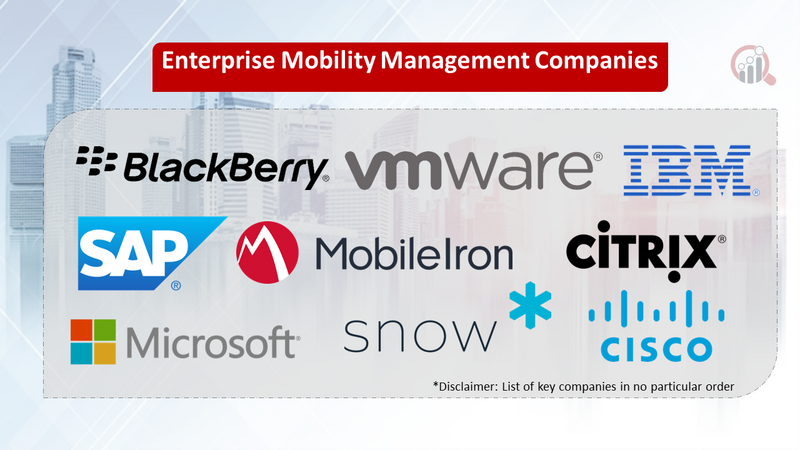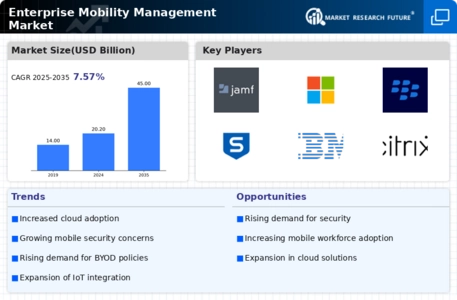Top Industry Leaders in the Enterprise Mobility Management Market

The Competitive Landscape of Enterprise Mobility Management (EMM): A Dynamic Terrain
The Enterprise Mobility Management market is a bustling arena, fueled by the burgeoning mobile workforce and the increasing reliance on BYOD (Bring Your Own Device) policies. This dynamic landscape sees established players vying for market dominance alongside nimble newcomers, all offering diverse solutions to secure and manage corporate data on mobile devices.
Key Players:
-
IBM (US)
-
Microsoft (US)
-
Cisco (US)
-
BlackBerry (Canada)
-
VMware (US)
-
SAP (Germany)
-
Citrix (US)
-
Matrix42(Germany)
-
MobileIron (US)
-
Nations (China)
-
Snow Software (Sweden)
-
Sophos (UK)
-
SOTI (Canada)
-
Codeproof (US)
-
Netplus Mobility (US)
Strategies Adopted:
-
Cloud-based Solutions: The shift towards cloud-based EMM platforms is gaining momentum, offering scalability, accessibility, and reduced upfront costs. Players are increasingly investing in cloud infrastructure and partnerships with cloud providers.
-
Integration and Automation: Integration with existing IT infrastructure and security solutions is crucial for seamless workflows and data governance. Players are focusing on API integration, pre-built connectors, and automation tools to simplify deployment and management.
-
Zero-Trust Security: The rise of advanced cyber threats necessitates robust security measures. Players are incorporating zero-trust principles such as multi-factor authentication, data encryption, and device isolation into their EMM offerings.
-
User Experience Focus: Ease of use, intuitive interfaces, and mobile-first design are key differentiators in the EMM market. Players are prioritizing user experience to ensure employee adoption and boost productivity.
Factors for Market Share Analysis:
-
Product Portfolio: The breadth and depth of features offered, including device management, application security, data protection, and endpoint security, are crucial factors.
-
Customer Base: The size and industry focus of the customer base indicate the player's reach and expertise in specific sectors.
-
Pricing and Licensing: Competitive pricing models and flexible licensing options are critical for attracting and retaining customers.
-
Innovation and Partnerships: Investment in R&D, adoption of emerging technologies like AI and machine learning, and strategic partnerships with other technology vendors contribute to market share growth.
New and Emerging Companies:
Startups like Codeproof, Netplus Mobility, and Hexnode are disrupting the market with innovative solutions. They are leveraging AI and machine learning for advanced threat detection, automated incident response, and personalized user experiences. Their agility and focus on specific use cases make them attractive to niche markets.
Current Investment Trends:
-
Security and Compliance: With rising cyber threats and stringent data privacy regulations, EMM vendors are heavily investing in security features and compliance solutions.
-
Containerization and Application Management: The rise of containerized applications and cloud-native deployments is driving the demand for containerized EMM solutions. Players are integrating container management capabilities into their platforms.
-
Analytics and Reporting: EMM platforms are increasingly offering advanced reporting and analytics dashboards to provide insights into device usage, app performance, and security threats. This data-driven approach helps organizations optimize their mobile strategies.
Latest Company Updates:
-
January 25th, 2024: Microsoft Intune announces integration with Citrix Workspace, enabling seamless device management for hybrid work environments.
-
January 18th, 2024: VMware Workspace ONE unveils new features for identity and access management, bolstering security and user experience.
-
January 10th, 2024: BlackBerry acquires Cylance, a leading cybersecurity firm, to strengthen its EMM offerings and threat detection capabilities.
-
December 15th, 2023: Google Android Enterprise releases new features for zero-touch enrollment and device management, simplifying deployment and administration.









